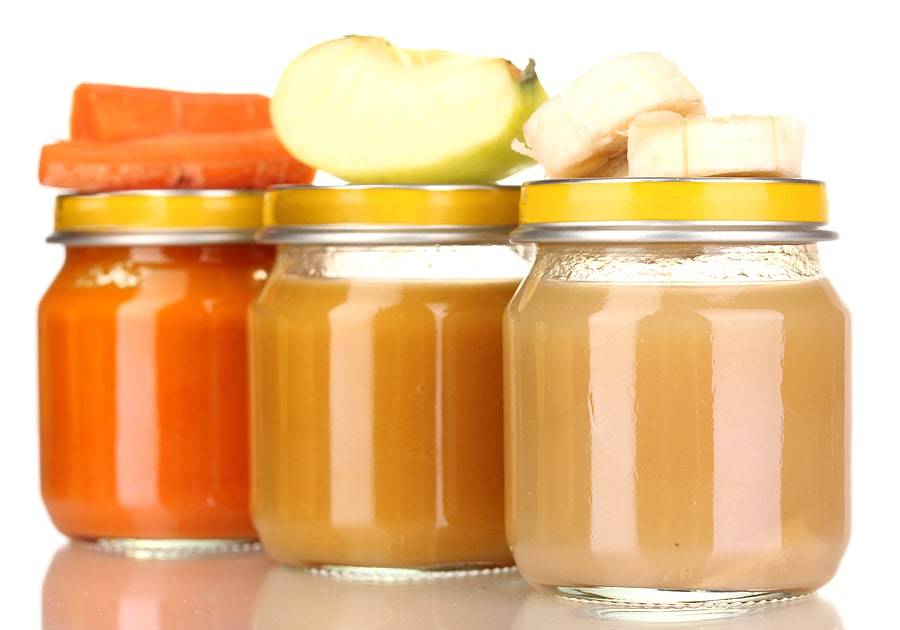Congressional Finding of Toxic Heavy Metals Necessitates Baby Food Recall
 The U.S. House of Representatives released a new report on February 4, 2021, indicating that commercial baby foods are tainted with “significant levels of toxic heavy metals, including arsenic, lead, cadmium, and mercury.” Exposure to such toxins has been associated with an increased risk of lowered IQ level, future criminal and antisocial behavior, and damaged neurological development.
The U.S. House of Representatives released a new report on February 4, 2021, indicating that commercial baby foods are tainted with “significant levels of toxic heavy metals, including arsenic, lead, cadmium, and mercury.” Exposure to such toxins has been associated with an increased risk of lowered IQ level, future criminal and antisocial behavior, and damaged neurological development.
At the time of the report, none of the manufacturers had announced a baby food recall. It remains to be seen whether the U.S. Food and Drug Administration (FDA) or other government bodies will take further action to help improve the safety of baby foods.
Previous Baby Food Study Shows Most Contaminated with Toxic Chemicals
Congress launched its investigation of baby foods after reviewing the findings of a previous study initiated by Healthy Babies Bright Futures (HBBF). HBBF is an alliance of scientists, nonprofit organizations, and donors working to reduce childrens’ exposure to toxic chemicals. The alliance for this study included partners Alaska Community Action on Toxics, Campaign for Healthier Solutions, Environmental Justice Health Alliance, Learning Disabilities Association of America, and more.
For the study, HBBF scientists tested 168 baby and toddler foods from 61 brands, including Gerber, Earth’s Best, Beech-Nut, and popular store brands. They reported on October 17, 2019, that 95 percent of the foods contained one or more toxic chemicals, including lead, arsenic, mercury, and cadmium. One-quarter of the foods tested contained all four chemicals, all of which can affect brain development.
Eighty-three percent of the foods tested had more lead than the 1-part per billion (ppb) limit endorsed by public health advocates, and one of every five foods tested had over 10 times that amount.
Certain Types of Baby Foods Contained High Toxin Levels
Certain types of foods contained notably high levels of heavy metals.
- Infant rice cereals: This is the number-one source of arsenic in infant’s diets. Four of the seven cereals tested contained inorganic arsenic (the toxic form of arsenic) at unsafe levels over the FDA’s recommended 100 ppb. These cereals are also most always contaminated with all four toxic metals. Toxicology and economic research firm Abt Associates estimates that lead and arsenic in rice-based foods account for one-fifth of the more than 11 million IQ points children lose from birth to 24 months of age from all dietary sources.
- Snacks: Puff snacks (rice) and other snacks made with rice flour are high in arsenic, containing about 98 ppb.
- Teething Foods: Teething biscuits and rice rusks often contain arsenic, lead, and cadmium. They also lack nutrients and can cause tooth decay.
- Drinks: Apple, pear, grape, and other fruit juices have lead and arsenic. The levels aren’t as high as in the other foods, but if infants and toddlers drink of lot of them, the levels can add up.
- Fruits & Veggies: Carrots and sweet potatoes are healthy and nutritious, but they can also contain lead and cadmium.
HBBF noted that parents shopping for baby food can choose safer alternatives to these foods. Unfortunately, choosing organic products or making similar products at home won’t necessarily help. The HBBF explains that heavy metals are naturally occurring in the soil and water and are also found at elevated levels in fields polluted by pesticides, contaminated fertilizer, airborne contaminants, and industrial operations.
Instead, HBBF suggests these alternatives:
- Instead of rice cereal, choose other infant cereals like multi-grain and oatmeal—84 percent lower toxin level.
- Instead of puff snacks, choose rice-free snacks—93 percent lower toxin level. Examples include apples, applesauce (unsweetened), bananas, beans, cheese, grapes (cut lengthwise), hard-boiled eggs, peaches, and yogurt.
- Instead of teething biscuits and rice rusks, choose other soothing foods for teething, such as a frozen bananas or chilled cucumbers—91 percent lower toxin level.
- Instead of fruit juice, choose tap water and milk—68 percent lower toxin level. Serve whole or pureed fruits instead of juice for more healthy fiber and nutrients.
- Choose a variety of fruits and veggies—up to 73 percent lower toxin level. The goal is not to consume too many carrots and sweet potatoes, but to give baby a variety of these and other fruits and vegetables.
Congressional Investigation Confirms the Presence of Toxins in Baby Food
After the HBBF released the results of their study, Congress launched its investigation into the safety of baby food on November 6, 2019. The Subcommittee on Economic and Consumer Policy requested internal documents and test results from seven of the largest baby food manufacturers in the U.S. These included:
- Nurture Inc. (Happy Family Organics, HappyBABY)
- Beech-Nut Nutrition Company (Beech-Nut)
- Hain Celestial Group (Earth’s Best Organic)
- Gerber
- Campbell Soup Company (Plum Organics)
- Walmart Inc. (Parent’s Choice)
- Sprout Foods, Inc. (Sprout Organic Foods)
Only four of the seven companies responded to the Subcommittee’s requests. Walmart, Campbell, and Sprout Organics refused to cooperate. The Subcommittee noted in its report its concern that this lack of cooperation may be obscuring the presence of toxic heavy metals in foods made by these companies.
The other four shared their internal testing policies, test results for ingredients and/or finished products, and documentation detailing company policies for dealing with ingredients and/or finished products testing at unsafe levels for toxins.
The committee then reviewed all the information and determined that commercial baby foods, in general, are contaminated with toxic heavy metals.
Which Baby Food Brands are Toxic?
Since Walmart, Campbell, and Sprout Organics didn’t cooperate with the Congressional investigation, the potential levels of toxic heavy metals in their products remain unknown. For the other four companies, the Subcommittee reported the following specific findings:
Arsenic Present in Foods Made by All Responding Companies
Over 25 percent of HappyBABY products Nurture tested before sale contained over 100 ppb inorganic arsenic, while the typical baby food product sold contained 60 ppb. Hain typically tested only ingredients, not the finished products, and documents showed it used ingredients testing as high as 309 ppb arsenic.
Beech-Nut used ingredients after they tested as high as 913.4 ppb arsenic, and routinely used high-arsenic additives. Gerber also used high-arsenic ingredients, including 67 batches of rice flour that tested over 90 ppb inorganic arsenic.
Lead Present in Foods Made by All Responding Companies
Nurture sold finished products that tested as high as 641 ppb lead, while almost 20 percent of its finished products tested contained over 10 ppb lead. Beech-Nut used many ingredients testing high in lead. Hain and Gerber did as well.
Cadmium Present in Foods Made by All Responding Companies
Beech-Nut, Hain, and Gerber all used ingredients that contained cadmium, most that tested over 20 ppb cadmium and some testing much higher than that. Sixty-five percent of HappyBABY products contained more than 5 ppb cadmium.
Mercury Present in Foods Tested for It
Only one of the responding companies regularly tests for mercury—Nurture. Its tests showed that it sold finished baby food products containing as much as 10 ppb mercury. Beech-Nut and Hain do not test for mercury in baby food, and Gerber rarely does.
Grave Concern Over Walmart, Campbell, and Sprouts Organics Baby Food
The Subcommittee noted its “grave concern” about baby products made by the three non-responding companies, noting that all three companies regularly sell products for babies as young as four months. They added that independent testing of Walmart, Sprout Organic Foods, and Campbell products “has confirmed that their baby foods contain concerning levels of toxic heavy metals.”
The Subcommittee called attention as well to a “secret slide presentation” given by Hain to the FDA in 2019. This presentation revealed that Hain’s policy (which mirrors the policy of other baby food manufacturers) of testing only ingredients rather than final products underrepresents the levels of toxic heavy metals in baby foods. In 100 percent of the Hain baby foods tested, inorganic arsenic levels were higher in the finished product than in estimates based on individual ingredient testing.
“The presentation made clear that ingredient testing is inadequate,” the Congressional report reads, “and that only final product testing can measure the true danger posed by baby foods.”
Congress Recommends Changes to Improve Safety of Baby Food
To improve the safety of baby food, the Subcommittee made the following recommendations:
- Mandatory testing: The FDA should require manufacturers to test their finished products for the presence of heavy metals.
- Labeling: The FDA should require manufacturers to provide warnings on product labels concerning the potential presence of heavy metals.
- FDA standards: The FDA should set maximum safety limits on toxic heavy metals permitted in baby foods. Currently, the FDA has proposed a safety limit only for arsenic.
- Phase-out toxic ingredients: Manufacturers should voluntarily phase out ingredients high in toxic metals and find safer alternatives.
Should these four recommendations be implemented, parents would be better informed about which products to avoid to protect the health of their babies.
Baby Foods Contain No Warnings of Dangerous Heavy Metals
 Though manufacturers are responsible for creating safe products and warning consumers of any potential health risks, baby food labels currently fail to warn parents of the dangers of toxic heavy metals. Further still, manufacturers are not required to test the final products to ensure they meet proper safety standards before selling them. Currently, they are free to test only ingredients or even not to test at all.
Though manufacturers are responsible for creating safe products and warning consumers of any potential health risks, baby food labels currently fail to warn parents of the dangers of toxic heavy metals. Further still, manufacturers are not required to test the final products to ensure they meet proper safety standards before selling them. Currently, they are free to test only ingredients or even not to test at all.
The Subcommittee noted that “baby food manufacturers hold a special position of trust,” and that consumers believe they sell safe products. To find out that this isn’t always the case damages not only the relationship between consumers and manufacturers but between consumers and the government agencies that are supposed to protect them. Contact our lawyers at Chaffin Luhana to learn more about your legal options.
